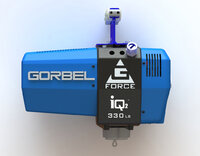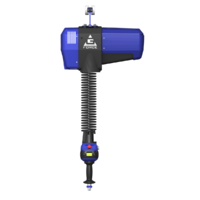Material Handling Equipment Specialist, Prolift Handling Ltd, Dublin And Cork, are Ireland`s #1 supplier of tested and certified material handling equipment products to a diverse range of industries including Food & Beverage, Logistics, Pharmaceutical, Medical, Wood and Automotive.
What is Material Handling Equipment?
Modern Material Handling Equipment (MHE) are ergonomically designed mechanical devices which make lifting, moving and storage during the process of manufacturing, distribution, consumption and disposal easier and safer in the workplace environment
We offer both stationary and mobile lifting devices and modify our products to provide standardised and customised solutions for the user. These products can handle everything from boxes and sacks, to cheese and windshields. Our range of lifting solutions enable a work environment that promotes safety and increases productivity. All of our equipment is supplied fully tested and certified.
Our Range of MHE products include:
- Vacuum Lifters
- ATEX Equipment
- Stainless steel solutions
- Mobile Lifters
- Vacuum Hoists
- Automatic keg lifters
- Air Skates
We offer a full consultation service and can organise a demonstration of our products or a site visit to discuss your needs about the equipment we have on offer. Discuss your requirements today - call 01-4584836 or email websales@prolift.ie
What Is Material Handling ?
You have probably wondered how all the products you have ever purchased got to you in the first place. The material handling industry is responsible for how these products are stored, protected, and moved from one point in the supply chain to the next. All the way to your local store or doorstep. As products are shipped across the globe, one industry is responsible for the safe delivery of nearly every type of material, product, and consumable. As companies are learning how to produce their products quicker and in greater quantities, Prolift Handling Ltd stays abreast of all technological advancements to ensure you can avail of the very latest products. The material handling industry is powered by a large variety of equipment to power the supply process. Storage equipment, lifting equipment, conveyor belts, and information technology are all utilised to keep the material handling industry functioning and constantly evolving.
1. Handling and storage equipment -These are items such as Drive-through or drive-in racks, Pallet Racks, Push-back Racks, Shelving, Sliding Racks, Stacking Frames.
2. Engineering systems Material Handling - Engineering Systems include AGVs, conveyor belts or robotic delivery systems (complex systems that come in different shapes and sizes), or Automated Storage and Retrieval System (AS/RS), which are automated systems often incorporating AGVs which make warehouses more efficient.
3. Industrial transportation - Examples of Industrial Transportation Trucks stocked by Prolift Handling Ltd Ireland and used in Material Handling Equipment Industry are Hand Trucks, Manual And Electric Pallet Trucks ( Pallet Jacks), Pallet Walkie Stackers (These are pallet trucks with man ride on capabilities) , Platform Trucks, Order Pickers, AGV`S (An AGV is a robotic type device which follows guide wires, markers or other in floor guides. AGVs can also utilise lasers, magnets or cameras for guidance. They are often used in large-scale industrial applications to move materials around a warehouse. AGVs can also use lasers, magnets or cameras for guidance.
Essential warehouse furnishings include, shelving units, pallet racks and other storage units. Essential includes forklifts, pallet jacks and other moving equipment. Then there are storage containers, forklift accessories, ladders, personnel lifts and a host of other items. All of them are necessary for the smooth running of the operation. Prolift Handling Ltds`online shop have have all the material handling supplies that your company needs.
Characteristics of materials handling are:
Package design: Product packaging in standard configurations and order quantities facilitates logistical efficiency. Total weight can sometimes be reduced by product or package changes. Even when package design is not changed products that weight out before cubing out may offer special opportunities. As light weight product can be top load to take advantage of the empty cube without substantially changing total weight or transportation cost.
Unitisation/ containerisation: Unitisation is the process of grouping master cartons into one physical unit for materials handling or transport. The concept of containerisation includes all forms of unitisation from taping two master cartons together to the use of specialised transportation equipment.
Communication: The third important logistical packaging function is communication or information transfer. This function is becoming increasingly critical to provide content identification, tracking and handling instructions.
Role of materials handling in logistics
Material handling has become a new, complex, and rapidly evolving science. For moving material in and out of warehouse many types of equipment and system are in use, depending on the type of products and volume to be handled. The equipment is used in loading and unloading operations for movement of goods over short distances. The handling of material in warehouse is restricted to unitized forms which requires size equipment. However, for bulk handling of material at logistics nodes such as shipyards, ports and airports, different types of equipment are used.In warehouses, material handling operation is performed at the following stages:
1. Unloading the incoming material from transport vehicle.
2. Moving the unloaded material to assign storage place in warehouses.
3. Lifting the material its storage place during order picking.
4. Moving the material for inspection and packing.
5. Loading packages, boxes, cartons on to transport vehicles.
The efficiency of material handling equipment, adds to the performance level of the warehouse. The internal movement of goods has a direct bearing on the order picking and fulfilment cycle. There is a scope for reducing labour and enhancing productivity by emerging technology in material handling. A good handling system will enhance the speed and throughput of material movement through the logistics. Material handling cannot be avoided in logistics but can certainly be reduced to minimum levels. The productivity potential of logistics can be exploited by selecting the right type of handling equipment. The selection of material handling equipment cannot be done in isolation without considering the storage system. Investment in the material handling system will be sheer waste if it is not compatible to the warehouse layout plan. The layout will create obstacles for free movement of equipment and goods resulting in poor equipment productivity. Recent trends indicate preference for automated system with higher logistics productivity to enhance the effectiveness of human energy in material movement. Similarly, good material handling systems give you control on productivity. “Improving your material handling system fuels a stunning return on investment. It makes more sense than almost anything else you can do.” By gaining control of your warehouse, you gain control of your profitability. Effective material handling systems create savings, that helps directly to improve your bottom line. If your business relies heavily on manufacturing, warehousing, storage or distribution, the potential savings are perhaps your greatest opportunity.
Issues of application: All logistical operations are affected by packaging utility from truck loading and warehouse picking productivity to transportation and storage cube utilisation.
Materials handling: Basic handling considerations. Logistical materials handling is concentrated in and around the warehouse. A basic difference exists in the handling of bulk materials and master cartons. There are several basic principles to guide the selection of materials handling processes and technologies.
Mechanised systems: Mechanised systems employ a wide range of handling equipment. The types of equipment most commonly used are lift trucks, man on rider pallet trucks, tow lines, tractor railed devices, conveyors and carousels.
Semi-automated systems: Mechanised handling is often supplemented by semi-automatic equipment. Typical equipment utilised in semi-automated handling includes automated guided vehicle systems, computerised robotics and various forms of live racks.
Information directed systems: The concept of information directed handling is relatively new and the subject of a great deal of research and development. The concept is appealing because it combines the control typical of automated handling with the flexibility of mechanised systems. Information directed systems use mechanised handling controlled by information technology. Two common exam of information-directed materials handling systems are, RF controlled equipment and light-directed operations.
Special handling considerations: The primary mission of materials handling is to facilitate merchandise flow in an orderly and efficient manner, from manufacturer to point of sale. This section identifies and discusses special handling considerations.
Issues of Application: Investments in materials handling technology and equipment offer the potential for substantially improved logistics productivity. Material handling processes and technologies impact productivity by influencing personnel, space and capital equipment requirements. It is important to understand that materials handling is a key logistics activity that can’t be overlooked.
What Is A Unit Load? A unit load is very often used in the material handling of discrete load materials. A unit load is a collection of materials, so arranged and restrained that it can be handled stored and controlled as a single entity. The advantages of using a unit load are amongst others the uniform handling and uniform storage operations, the reduced burden on information and control systems. In addition, unit loads allow efficient macro external space utilisation. Since each load is the same size and storage locations can be sized to accommodate this unit load and the loads can be packed tightly together without gaps. The disadvantages of using a unit load are the cost of assembling and disassembling the unit load and the cost of the empty returnable container handling or the disposal cost of single-use containers. In addition, unit loads can have inefficient micro internal space utilisation if the unit loads can be completely filled up.
Storage and Retrieval Systems. Storage and retrieval systems provide the combined function of handling and storage the material. Examples are unit load automated storage and retrieval systems (ASRS). With store and retrieve whole pallets mini-load systems with storage drawers. Micro load systems with storage totes sometimes also called ‘Tote Stackers’, and carousels with extractors. An A-frame is an automated order picking system used for high-speed high throughput order picking of small and well-packaged items. There are some terms that are used in the storage principle. These terms are as follows:
Temperature: Temperature is very important when it comes to food storage and you will often find lots of thermometers around the storerooms. The ideal store room temperature is between 10 and 20 degrees Celsius.
Humidity: Humidity is another thing that needs to be considered in the storeroom. The humidity in the dry store areas should be between 50% and 60%. If the humidity gets too high when the air cools, it will release this excess moisture in the form of water droplets which end up covering the walls and floor of dry storerooms.
Position: Position is also important when storing stock particularly storing stock on shelves.
Rotation: Stock rotation is another important storage principle. Stock rotation is where you put all new stock to the rare or underneath already stored stock so that existing stock is used first.
Employment Within The Industry: The material handling industry has opportunities for those with expertise in engineering, production and operations, manufacturing, administration, logistics, inventory control, supply chain management, systems integration, marketing and sales, information technology, customer services and facility design.








